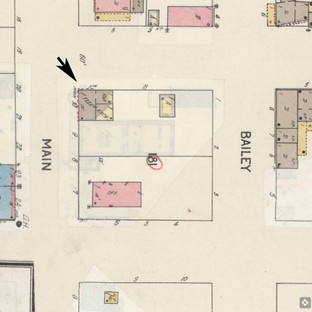Florence, Arizona: The Cuen House, a.k.a. the McFarland & Fulbright Law Office
- Bob Graham

- Jan 16, 2020
- 4 min read
Updated: Apr 4, 2022
Historical Background and Chronology of Development

Florence, Arizona was founded in 1866 in what was then Pima county, Arizona Territory. Levi Ruggles, the founder, surveyed the initial townsite. When Pinal county was created out of portions of Maricopa and Pima counties in 1875, Florence, near the center, was named County Seat.
Residential Period
Francisco Cuen and his wife Maria Antonia Cuen immigrated to Arizona from Mexico some time prior to 1883. Francisco was a butcher by trade and the two settled in Florence, building an adobe home and butcher shop along Main Street on a parcel he purchased that year. The first evidence of the house’s form appears as the footprint of an existing structure on the Florence Townsite plat map filed with Pinal County on March 13, 1883.
Homes in the Sonoran regional vernacular typically grew starting from an initial structure by adding rooms along the street fronts to enclose the interior of the lot. It is likely that the house started as a one- or two-room building fronting on Main, but by 1890, at least three additional rooms along 11th Street extended back about 80 feet in that direction, forming an L. Typical characteristics of this period would have included thick adobe walls throughout, supporting relatively flat clay roofs supported on log vigas spanned by lighter latillas of saguaro ribs or straight tree branches. Floors would have been earth, or wood flooring on joists or sleepers laid on the ground. The house subsisted in this form until sometime after 1898.
Telephone Exchange
In about 1902 the house was purchased by the Sunset Telephone and Telegraph Company of San Francisco for one of four telephone exchanges being set up in Arizona. The exchange served Florence, but also a wider region in this part of the territory. The extent of initial alterations that might have been made for this new use are not known. Sunset’s assets were purchased in 1910 by the Consolidated Telephone and Telegraph Company. In October, 1910 the building was extensively remodeled. It is likely that the work included the removal of most of the 11th Street wing of the house, the back porch, and the old Sonoran style flat roofs and construction of new wood framed, pitched roofs and beadboard ceilings. The results are documented by the 1911 Sanborn Fire Insurance map, which shows a two-room office building.
McFarland & Fulbright Law Office
Earnest McFarland is one of Arizona’s most notable historic characters for a simple reason: he is the only person ever to serve in all three branches of State government as well as being one of the State’s senatorial delegates to the U.S. Congress. Mac, as he was known, came to Arizona from Oklahoma in 1919. He filed a homestead claim near Casa Grande before going off to Stanford University to study Law. He received his JD and bar admission in 1922, and moved to Florence in 1924 to satisfy the residency requirement to serve as Pinal County Attorney.
McFarland’s connection to the Cuen House began shortly after he left his post as County Attorney in 1929. In 1930, he and his partner Tom Fulbright set up a new private law practice as McFarland & Fulbright Attorneys. The new firm apparently leased the old exchange building from the telephone company as their office. This lease may have been the impetus for a new renovation of the building, which included reconstruction of the Main Street front wall out of brick and filling in the back corner of the house to turn the L shaped plan into a clean rectangle. The room addition was constructed of wood frame and included the addition of a skylight in the roof spanning the two back rooms.
In 1935, McFarland was elected a judge, holding that position until 1940, after which he began his remarkable political career. He eventually returned to private law practice in 1958, but only remained until 1964 when he was elected to the Arizona Supreme Court. Tom Fulbright continued to work out of the Cuen House until his death on November 13, 1972, in the parking lot across the street after leaving work.
Years of Disuse
The building remained empty for the most part after Fulbright’s passing. A false board-and-batten front was added to the façade for the 1977 TV movie “Escape from Bogen County” starring Jacklyn Smith. The corrugated roof may have also been added at that time, as fire insurance maps indicate that the roof was of composition roofing prior to this.
During all of these years, the property remained under telephone company ownership, which by 1989 was US West Communications. US West wanted to demolish the Cuen house for an improved switching center. However in 2002, though negotiations with (then) Qwest by the Town of Florence and preservation advocates, the property was deeded to the Town in return for allowances made on the balance of the property.
The building was not yet safe, however, as the Town worked with the Florence Industrial Development Authority (IDA) to get the building rehabilitated. The IDA sold the property to a private developer, Langley Properties, who attempted the rehabilitation, and even getting full architectural drawings for the work. The developer failed to perform in the end, and the Town reacquired the building in 2013 as a gift. Tom & Lynn Smith purchased the property from the Town in 2019, beginning the latest effort to successfully finish the project.
Progression of site development of the Cuen House block. Shown: 1890, 1898, 1911, 1915, and 1941















Comments